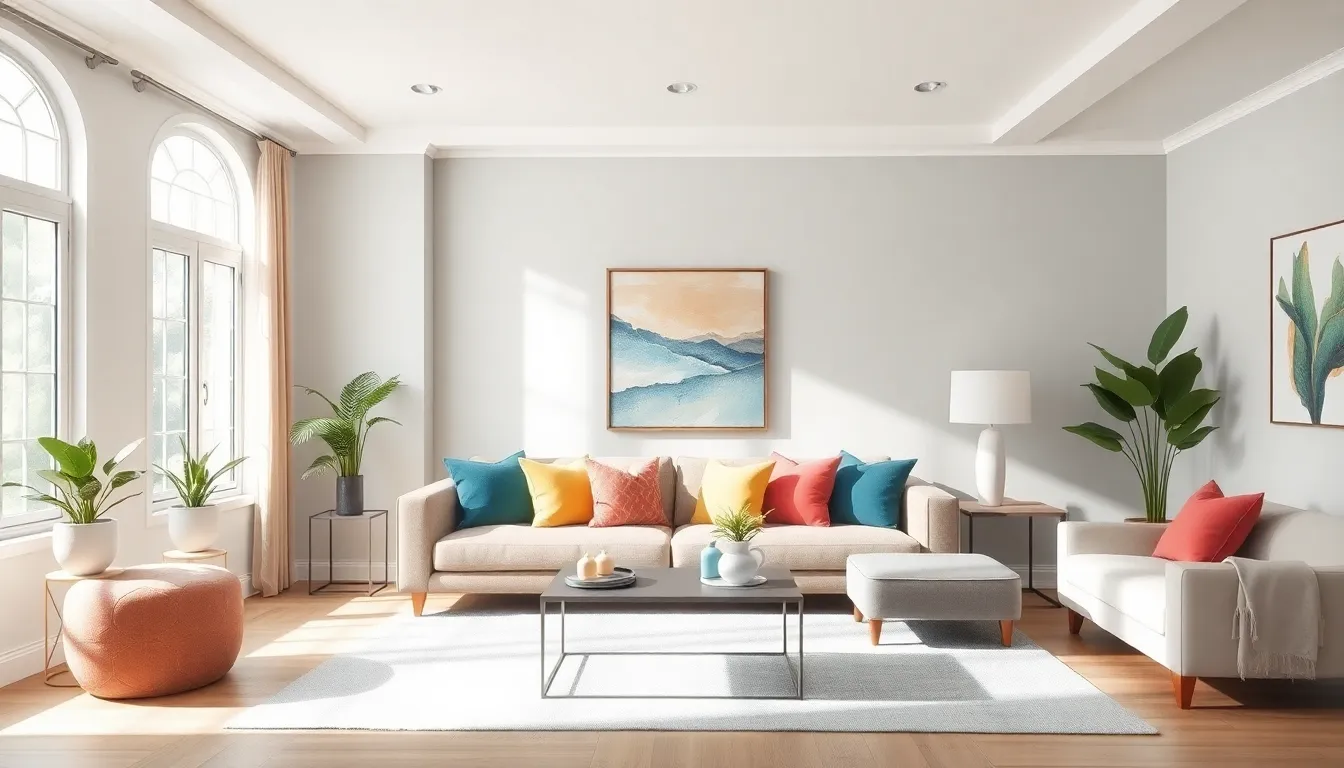Transforming a space can feel like an overwhelming task, but it doesn’t have to be. With the right interior design tips, anyone can turn their home into a stylish sanctuary without breaking the bank or losing their sanity. Imagine walking into a room that feels just right—each piece harmonizing like a well-rehearsed band.
Table of Contents
ToggleEssential Interior Design Tips
Choose a color palette that reflects personal style and enhances the home’s atmosphere. Neutrals, such as grays or beiges, provide a versatile backdrop while bold accents add character.
Incorporate various textures to create depth. Mix materials like wood, metal, and fabric for a dynamic look. Layering textiles, such as cushions or throws, also invites comfort.
Select furniture wisely to ensure functionality and aesthetic appeal. Opt for multi-purpose pieces that save space, especially in smaller areas. Choosing the right scale prevents overcrowding while maintaining flow.
Emphasize lighting to set the mood in any room. Use a mix of ambient, task, and accent lighting for versatility. Pendant lights or floor lamps create focal points.
Display artwork and decorative pieces strategically to personalize the space. Group smaller items together in odd numbers for visual interest. Large pieces can act as statement elements on walls.
Maintain balance and symmetry to achieve a harmonious appearance. Arrange furniture in a way that encourages conversation while ensuring ease of movement. Use rugs to define spaces and anchor furniture arrangements.
Consider plants to bring life into interiors. Incorporating greenery enhances aesthetics and promotes well-being. Choose low-maintenance varieties for ease of care.
Regularly reassess and refresh the space to keep it feeling new. Small updates, like changing cushion covers or moving artwork, can significantly influence overall impressions. Prioritizing functionality alongside style turns any room into a sanctuary.
Color Schemes

Color schemes can significantly impact the mood and style of a space. Selecting the right palette sets the tone for an entire room.
Choosing the Right Palette
Choosing a palette requires consideration of personal style and desired atmosphere. Start with three to five colors that complement each other. Soft neutrals provide a versatile backdrop, allowing bold colors to shine. Accent colors can bring energy to a subdued space, adding vibrancy. When picking colors, consider the natural light in the room, as it affects how shades appear at different times of the day. Utilizing online design tools may help visualize combinations before committing to a choice.
Accent Colors vs. Neutrals
Accent colors and neutrals serve distinct purposes in interior design. Neutrals create a calming environment, fostering a sense of tranquility. They often work well as main colors, allowing for flexibility in décor choices. Accent colors, on the other hand, add personality and drama to a space. Implementing them through furniture, artwork, or decorative accessories makes an impact without overwhelming the overall design. Striking a balance between the two can enhance aesthetic appeal while maintaining a cohesive look.
Furniture Arrangement
Effective furniture arrangement transforms a living space into a functional and inviting environment. Strategic placement of furniture simplifies movement and emphasizes design elements.
Maximizing Space
Utilizing furniture dimensions ensures efficient use of space. Focus on selecting multi-functional pieces that facilitate versatility. For instance, a coffee table with storage enhances both utility and aesthetics. Consider furniture placement against walls to create an open feel. Arranging seating in conversation clusters fosters interaction while optimizing floor space. Additionally, incorporating mirrors can visually expand an area, reflecting light and depth.
Creating Flow and Balance
Establishing a seamless flow enhances visual appeal and comfort. Create eye pathways by arranging furniture to guide movement throughout the room. Pair larger elements with smaller pieces for dynamic balance. Accents, like side tables and decorative chairs, enhance proportion without overcrowding. Symmetrical arrangements promote harmony, while asymmetrical ones can add visual interest. Prioritize pathways for ease of movement, ensuring that each area feels accessible without obstacles.
Lighting Techniques
Lighting significantly influences the ambiance of a space. Understanding the interplay of natural and artificial light enhances design choices.
Natural vs. Artificial Light
Natural light enhances colors and creates a welcoming atmosphere. Large windows or skylights maximize sunlight, improving mood and energy levels. Positioning mirrors strategically reflects daylight, expanding the sense of space. Artificial light complements natural sources, providing consistent illumination during evenings. Using LED bulbs reduces energy consumption and increases longevity. Light placement impacts functionality—task lighting at workspaces and soft ambient light in relaxation areas establish the desired vibe.
Layered Lighting Solutions
Layered lighting involves three types: ambient, task, and accent. Ambient lighting serves as the primary light source, illuminating the entire room. Task lighting directs focus on specific areas, such as desks or reading nooks, enhancing functionality. Accent lighting highlights artwork or architectural features, adding depth to the design. Combining these layers creates balance and flexibility in achieving desired moods. Adjustable fixtures allow for easy switching between bright and soft lighting to match activity levels and occasions. By employing these techniques, spaces become more inviting and dynamic.
Personal Touches
Personal touches enhance the unique character of a space, reflecting individual tastes. Choosing decor that resonates with one’s personality connects the environment to personal experiences. Incorporating family heirlooms, favorite colors, and unique art pieces personalizes the interior. Displaying travel souvenirs or handmade items tells a story and adds sentimental value. Each piece, from photographs to sculptures, contributes to the overall ambiance. Curating these items thoughtfully can create a coherent narrative throughout the home.
Incorporating Personal Style
Adding personal style to a living space brings it to life with distinct flair. Selecting a signature color or pattern can serve as a thread throughout the decor. Mixing vintage and contemporary furniture pieces lends a sense of history while showcasing modernity. Embracing personal hobbies, such as music or art, creates engaging focal points. Integrating customized furniture or decor items enhances individuality and comfort. Emphasizing what resonates most ensures a space that feels uniquely theirs. Balancing personal tastes with functional design creates harmony in the environment.
Importance of Accessories
Accessories play a critical role in enhancing interior design and bridging gaps between elements. Layering textures through rugs, pillows, and throws adds dimension to spaces. Choosing statement pieces, like bold vases or artistic lighting fixtures, draws attention and sparks conversation. Incorporating plants introduces vibrancy and freshness, improving overall ambiance. Selecting artwork that aligns with personal preferences creates a reflective environment. Accessories change easily, making them an effective way to refresh a room. Investing time in curating these elements can significantly impact the elegance and warmth of any space.
Transforming a living space into a stylish sanctuary is an achievable goal for anyone. By focusing on color palettes textures and lighting, individuals can create environments that reflect their unique personalities and enhance their well-being.
Incorporating personal touches and thoughtful accessories adds depth and warmth to any room. Regularly reassessing design choices ensures that spaces remain fresh and inviting.
With these tips in mind it’s possible to design a home that not only looks beautiful but also feels comfortable and functional. Embracing creativity and experimentation will lead to a space that truly feels like home.


